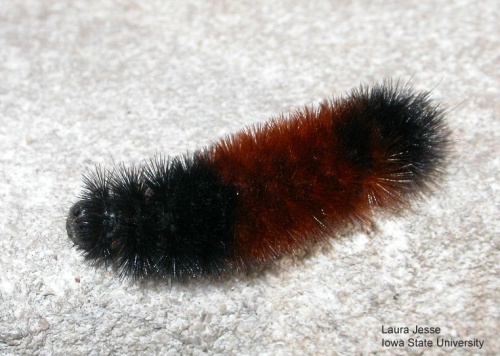Can a caterpillar really predict whether Iowa will have a mild winter?
October 28th, 2024 by Ric Hanson
(Radio Iowa) – An expert at Iowa State University’s Insect Zoo says there may actually be some science behind the folklore about how the thickness of a Woollybear caterpillar’s stripes can help predict the severity of the winter ahead. Ginny Mitchell, the insect zoo’s education program coordinator, says a fellow entomologist in New York studied the fuzzy creatures in the 1940s. “He sampled all of the woolly caterpillars in the area for nine years, and during that time, there was actually some correlation between the markings on the woolly caterpillar and the winter,” Mitchell says, “but that study had a very small sample size, so people do not consider it scientifically factual.”
The black-and-brown caterpillars are prevalent in Iowa right now as they’re looking for safe places to spend the winter. As the story goes, Mitchell says the thickness of the caterpillar’s center stripe is key in weather forecasting. “The rusty, kind of orange color, if that band is really big, that means we’re going to have a mild winter,” Mitchell says. “If the black parts of the woolly caterpillar are very large, it’s going to be a more severe winter. If there is more hair on the woolly caterpillar, then that means that it’s going to be a more severe winter.” 
There are also theories that if the caterpillar is crawling south when you find it, it’s trying to flee the looming northern cold, and the reverse, if it’s heading north, a mild winter is ahead. At least two communities — Vermilion, Ohio and Banner Elk, North Carolina — have fall festivals devoted to the alleged prognosticating abilities of the woolly bear caterpillar. One remarkable fact, Mitchell says these fuzzy critters hibernate during the wintertime and their bodies contain a sort of natural antifreeze. “Say you’re out raking leaves or moving some brush and you find one, it will kind of look like it’s dead. It’ll be curled up like a ‘C’ and it won’t be moving very much,” Mitchell says, “but if you take it inside and you warm it up, then it’ll start to move.”
There are reports of woolly bear caterpillars surviving temperatures as low as 90-degrees below zero, even spending an entire winter frozen in an ice cube, to emerge just fine in the spring. Once temperatures warm up for the season, it will create a cocoon and emerge a few weeks later as an Alexandra or Isabella tiger moth.





